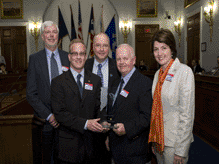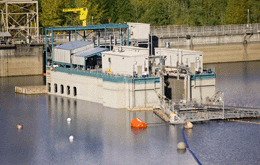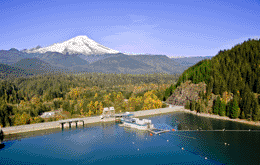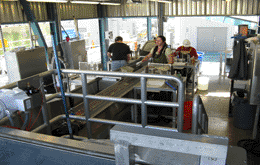Floating Surface Collector and Fish Passage Implementation Plan

PSE receives the OSAW award at NHA’s Capital Hill rally on May 11, 2009.
Summary
In spring 2008, Puget Sound Energy completed construction of a new floating surface collector (FSC) for the passage of downstream-migrating juvenile salmonids at the Baker River Hydroelectric Project in Washington state. Successful first-year operation and performance show promise for the application of the technology in deep-water reservoirs throughout the region.
Development of the FSC was a collaborative effort involving resource agencies, tribes, engineering and biological consulting firms, and Puget Sound Energy (PSE). Design concepts reflect over 20 years of biological evaluations and incremental improvements to the original collectors and passage system, which helped to reverse the steep decline of the Baker River’s predominant population of sockeye salmon.
The FSC is a vee-screen channel and fish holding complex contained within a floating facility. Pumps draw water and fish into the channel, past screens, and into holding areas. The FSC and fish passage facilities, in association with the implementation of other license articles, will contribute to the expansion of the Baker River’s salmon populations, with associated benefits to tribal, recreational, and commercial interests, as well as to the region’s environmental quality and improved standard of living.

Puget Sound Energy’s floating surface collector has significantly increased the recovery rate of salmonids. In some cases, the recovery rate exceeds 95 percent, roughly double the rate of older generation fish collectors.
Background
The Baker River system is home to eight species of anadromous salmonids. Coho and sockeye salmon are the two most abundant species in the basin, averaging 94% of the adult salmonids returning to the Baker River upstream migrant trap. The sockeye stock, very important to the region because of its uniqueness, has been actively managed since 1895 by both state and federal agencies.
Since the completion of the Lower Baker dam in 1929, fish passage has been an important issue in the Baker River system, and many techniques have been adopted over the years to ensure salmonids can migrate downstream. First generation FSCs or “gulpers” have been used at Upper and Lower Baker dams since the 1960s and, with modifications in the 1980s, have shown to be an effective tool to improve fish passage, especially in deep-water reservoirs.
During the relicensing of the Baker River Project, PSE’s fish passage technical team reviewed all passage alternatives to replace existing facilities and, after an exhaustive selection process, determined that the floating surface collector was most applicable for the project.
The new floating surface collector is the first of several next-generation deep-water reservoir surface collectors coming on line in the next decade and is a prime example of this important emerging technology.

The Baker River Hydroelectric Project in Washington state features a deep water reservoir. The new floating surface collector has proven to be an effective tool for enhancing fish passage at these facilities.
Challenge
Given the importance of fish passage in the Baker River system and the limitations of existing passage technology, PSE had to devise an efficient and cost-effective way to safely pass as close to 100% of migrant salmonids as possible from a deep-water reservoir.
Accomplishing this goal presented various technical challenges in the design and installation of the FSC. With reservoir levels capable of fluctuating at least 50 feet, obstacles emerged in the position control of the free floating structure and its ability to access and transport fish.
The design of the facility also had to account for the ability of operators to pass flood flows through the reservoir in a way that did not require the removal of the facility. Moreover, uncertainty regarding design assumptions with the corresponding need to address issues such as acceleration and capture velocity also posed a challenge.

Workers on the floating surface collector ensure that fish pass safely through the Baker River project. The floating surface collector transports fish to trucks that haul them around the dam.
Innovation
Reservoir fluctuations required the design of a complicated moorage system consisting of 13 anchor points and lines. The addition of a stairway tower and landing platform to the dam face as well as a cableway and docking station for access and transport helped the project adapt to the reservoir fluctuations.
A deflatable guide net floatation allowed the permanent installation of guidance facilities while providing operators with the ability to deal with infrequent flood events.
The use of guide nets as a “soft screen” was also innovative in that shoreline-to-shoreline, surface-to-bottom exclusionary netting provided a cheaper alternative than conventional “hard screens.” Computer modeling techniques helped direct the design of the guide nets to optimize guidance flows in this “soft screen” technology.
Results
The mean fish recovery rate of the new FSC was 75% during the first year of operation. With an agreed adjustment for study impacts on performance, the recovery rate approaches the 95% performance standard and exceeds it in some study treatments. This compares to a rate of between 49-52% for the old Upper Baker “gulper.”
The success of the project’s relicensing hinged on the selection of an effective downstream fish passage facility. When compared to the likely alternative, at an estimated cost of as much as 17 times that of the FSC, the $50 million project cost proved to be a bargain. Furthermore, it not only secured a 50-year license, but also solidified a collaborative relationship with stakeholders to address future issues.
Stakeholder Quotes
“I’m hoping that what we learn through our evaluation of the FSC is that it provides the level of success, fish passage effectiveness, that we’re looking for and that the Baker FSC will become the model for the silver bullet regionally, that this will be the model or concept around which downstream fishways are built at storage projects. We don’t have successful fish passage at hydro storage projects, yet there are a fair number of fish restoration plans that are wholly contingent on the ability to successfully pass juvenile fish from storage reservoirs behind power dams and so if the Baker FSC is as successful as we hope and other models are developed from this prototype, I expect to see – certainly want to see, in fact I do expect to see – a host of other fish restoration programs become successful building on the success of this particular fishway.” — Steve Fransen, Fisheries Biologist, National Marine Fisheries Service
“… Puget Power was working with the tribe and other co-managers here to further the sustainability of the sockeye run, and they’ve done a good job over the years of working with us and the Department of Fish & Wildlife to bring that run back to where it is today, where it’s actually harvestable now – there’s harvestable numbers of fish – that the Tribe fishes on, and to Puget’s credit, they’ve done a bang-up job I guess, if you would, of meeting that challenge after that bleak year of ‘85.
“Well, again, I think they’ve done a phenomenal job and have stepped up to the plate over the years and to work with us and the state to promote sustainable runs on the Baker and they’ve been very supportive of the Tribe, sustaining our tribal fisheries, which of course is very important to us too.
“We actually had a base for a very good relationship with Puget Power prior to the relicensing discussions. You know, we’ve worked in the Valley for years and we knew most of their employees and we had a long history of a presence there, so it wasn’t a big step for us to take that initial relationship and turn it into a close tie during the relicensing discussions, I guess, with Puget Power, and they’ve always worked with us.” — Scott Schuyler, Policy Representative & Tribal Member, Upper Skagit Indian Tribe


